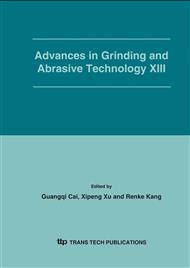p.359
p.364
p.369
p.374
p.379
p.384
p.389
p.393
p.398
The Principle of Magnetic Abrasive Finishing under Rotating Electromagnetic Field and Its Application in Surface Finishing of Heavy Crankshaft
Abstract:
Magnetic abrasive finishing (MAF) is a processing technology using magnetic abrasive grain (MAG) under magnetic field to finish surface of workpiece. The magnetic fields used in MAF include permanent magnetic field and electromagnetic field. Two conditions must be taken into consideration in the finishing surface of workpiece. One is the sufficient cutting force; the other is the relative moving speed between MAG and workpiece. The principle of step-motor rotating magnetic field is used to produce rotating magnetic field (RMF) in this paper. RMF brings MAG to rotate and keeps workpiece immovable. Meanwhile, the coins vibrate within a definite angle range and reciprocate in axial direction so as to process the outer cylindrical surfaces. Yoke iron is made of two halves so that the coins for rotating magnetic field will be keyed to some section of heavy crankshaft, thus realizing cylindrical surface finishing on the heavy crankshaft. MAG are of importance to MAF . Six performance indexes related to MAG are suggested by studying on process parameters.
Info:
Periodical:
Pages:
379-383
Citation:
Online since:
February 2006
Authors:
Price:
Сopyright:
© 2006 Trans Tech Publications Ltd. All Rights Reserved
Share:
Citation:


